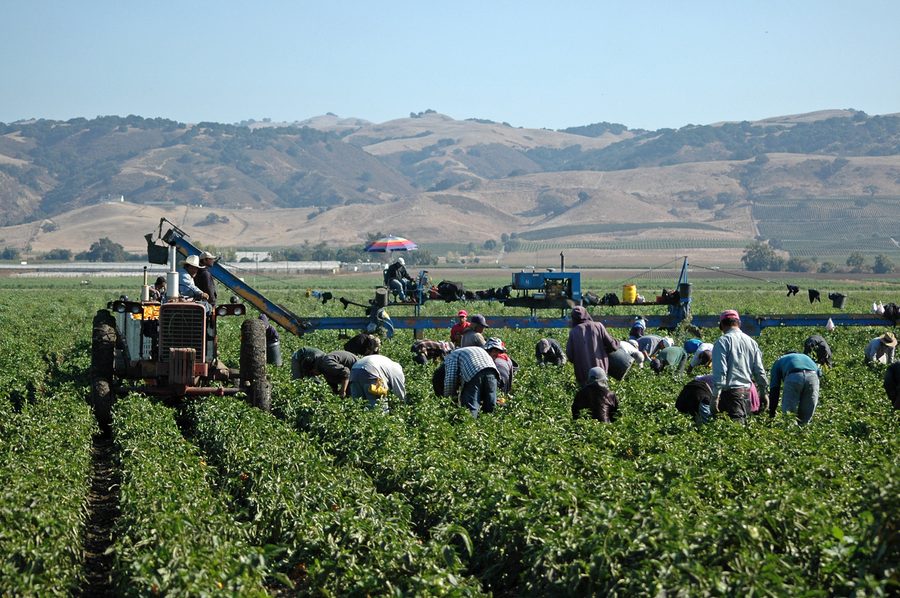They Pick Food All Day, But Many Farmworkers Go to Sleep Hungry
Immigrant farmworkers in the U.S. often live in food deserts without access to the fruits and vegetables they spend their days harvesting.
Astra Lincoln Writers on the Range

On a summer morning in southern Idaho, the day breaks early, before 6 a.m. The air is stale, never fully cooled from the heat of the day before.
In the indigo hour when night becomes morning, dozens of people — most from Mexico — queue for the van that will shuttle them to the picking fields. For the next 15 hours, they harvest. Ladders teeter on the uneven, parched earth. Cherries are quickly pulled from high branches by the handful.
The fruit isn’t for them. Like most regions in the country whose economies rely on exporting food, little of what’s picked here makes it onto the plates of the people who harvested it.
At the end of the daylight hours, a company bus returns and drives the farmworkers to the Walmart, on the far side of town, where they can shop for groceries and gloves. Farmworkers forced to shop late at night have frequently been met with depleted shelves ever since the early days of the pandemic. They buy what little they can, then re-board the van that brings them home. Many fall asleep hungry.
In 2020, when the pandemic began, organizer Samantha Guerrero drove across the low, parched hills of Idaho’s Canyon County to a neighborhood she calls Farmway Village. First built as a labor camp, the low-income housing complex has become home to many of the county’s agricultural employees. Guerrero had planned to distribute information about the new virus. But what she found wasn’t a lack of information; it was a lack of good groceries. She’s been working to change that ever since.
For immigrant farmworkers, food is in short supply: “The only thing close to that place is a gas station,” Guerrero told me. “That means they only have access to the processed foods sold there.”
Guerrero works for the nonprofit Idaho Organization of Resource Councils, which is trying to change things. Recently, it started distributing culturally relevant foods, like masa for corn tortillas, and some local, organic farmers let volunteers glean produce like tomatoes and pumpkins to redistribute.
Yet the need is widespread — in Idaho and elsewhere where farmworkers are needed — and even the best-organized mutual aid projects can’t meet the demand. Nonprofits try to help, but they aren’t equipped to make the systems-level changes needed to end the lack of nutritious food and the hunger suffered by farmworkers and other immigrants.
Local food pantries try, but they’re not always an answer. Many farmworkers come from agricultural communities south of our border with Mexico, Guerrero says. They’re used to fresh fruits, home-raised meats, or hand-pressed tortillas. Even though these immigrant communities are the primary audience for many food pantries, the canned and boxed food they provide can be unrecognizable to the people they serve.
This holds true across the West. I’ve spoken to other farmworkers and organizers in Montana, Oregon and the Dakotas, and all echo those sentiments. We haven’t diminished the hunger of the workers who feed us.
There are more than 2.4 million migrant and seasonal farmworkers in the United States. For more than 20 years, migration from Mexico has been largely driven by economic hardship that began in 1994, when the North American Free Trade Agreement (NAFTA) crashed the value of the peso. Now, migrants from that country and Central America are increasingly coming north to escape drug violence, or when landslides, hurricanes and other disasters hastened by the changing climate force them to flee.
When many workers land at large, corporate-owned farms, they sometimes find harsh conditions; this February, for example, the U.S. Department of Labor found that one large Idaho farm had shortchanged its 69 workers by $159,000.
Ninety-one percent of counties with the highest rates of overall food insecurity are rural, and workers there face soaring costs of food and a declining number of grocery stores, as consolidation and rising real estate values close outlets. Although farmworkers harvest fruit and vegetables all day, it is odd, but true, that they are living in “food deserts.”
“I have to say,” Guerrero says, sighing, “that there is a lot of abundance (in Idaho). There is enough to go around. It’s just all going elsewhere.”
Astra Lincoln is a contributor to Writers on the Range, writersontherange.org, an independent nonprofit dedicated to lively debate about Western issues. She writes in Oregon.




